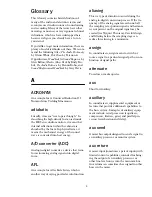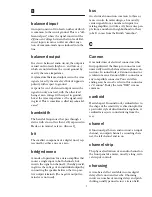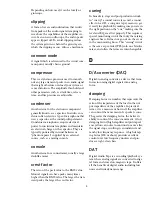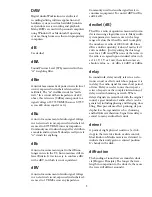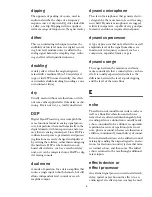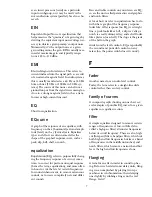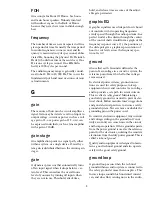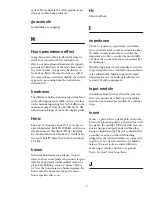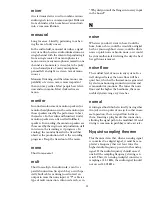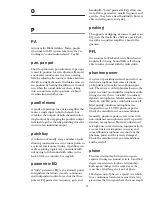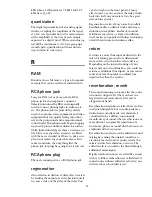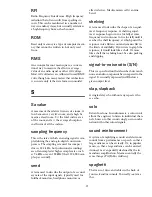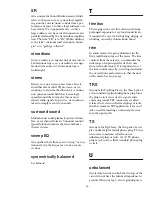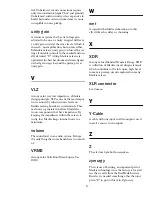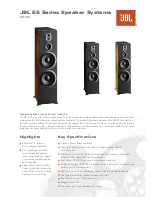
8
FOH
An acronym for Front Of House. See house
and main house speakers. Nobody involved
with audio ever goes to the Back of House
because they never have time to drink enough
beer.
frequency
The number of times an event repeats itself in a
given period of time. Generally the time period
for audio frequencies is one second, and fre-
quency is measured in cycles per second, abbre-
viated Hz, honoring the physicist Dr. Heinrich
Hertz (who did not invent the rental car). One
Hz is one cycle per second. One kHz (kilo-
hertz) is 1000 cycles per second.
The audio frequency range is generally consid-
ered to be 20 Hz to 20, 000 Hz. This covers the
fundamental pitch and most overtones of musi-
cal instruments.
G
gain
The measure of how much a circuit amplifies a
signal. Gain may be stated as a ratio of input to
output voltage, current or power, such as a volt-
age gain of 4, or a power gain of 1.5, or it can
be expressed in decibels, such as a line amplifier
with a gain of 10 dB.
gain stage
An amplification point in a signal path, either
within a system or a single device. Overall sys-
tem gain is distributed between the various gain
stages.
gate
A dynamics processor that automatically turns
off an input signal when it drops below a cer-
tain level. This can reduce the overall noise
level of your mix by turning off inputs when
they are not in use. Threshold, attack time,
hold, and release time are some of the adjust-
able gate parameters.
graphic EQ
A graphic equalizer uses slide pots for its boost/
cut controls, with its operating frequencies
evenly spaced through the audio spectrum. In a
perfect world, a line drawn through the centers
of the control shafts would form a graph of the
frequency response curve. Or, the positions of
the slide pots give a graphic representation of
boost or cut levels across the frequency spec-
trum. Get it?
ground
Also called earth. Ground is defined as the
point of zero voltage in a circuit or system, the
reference point from which all other voltages
are measured.
In electrical power systems, ground connec-
tions are used for safety purposes, to keep
equipment chassis and controls at zero voltage
and to provide a safe path for errant currents.
This is called a
safety ground
. Maintaining a
good safety ground is essential to prevent elec-
trical shock. Follow manufacturer’s suggestions
and good electrical practices to ensure a safely
grounded system. Never remove or disable the
grounding pin on the power cord.
In sensitive electronic equipment, tiny currents
and voltages riding on the ground (so it’s not
truly zero volts) can cause noise in the circuits
and hamper operation. Often a ground separate
from the power ground is used as the reference
point for the electronics, isolating the sensitive
electronics from the dirty power ground. This is
called a
technical ground
.
Quality audio equipment is designed to main-
tain a good technical ground and also operate
safely with a good safety ground.
ground loop
A ground loop occurs when the technical
ground within an audio system is connected to
the safety ground at more than one place. This
forms a loop around which unwanted current
can, and does flow, causing noise in the audio
Содержание 1642-VLZ PRO
Страница 1: ...Glossary of pro audio terms...


